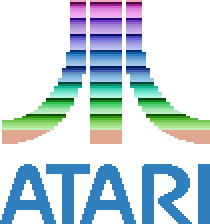
theNEWMEDIAREADER · 1970s · Atari Games, 1978-82

To a great extent, the Atari 2600 VCS not only defined what home console gaming was to be like, but also served as the thin edge of the wedge that drove more general-purpose desktop computers into the home. "VCS" stands for "Video Computer System," and although gaming was clearly the dominant purpose of the device there were educational cartridges for the Atari 2600 and even a cartridge that implemented BASIC and allowed the user to joystick through commands to piece together programs. Cartridges were what the system was all about; it was the first successful (though not the first) video game system with removable media, allowing new games to be programmed for years after the system's release. The way the Atari 2600 was positioned—as an entertainment system that brings the family together, as shown in the commercial included here—related to the marketing of the home computer and also to some of the early ways in which television was promoted. (Television has since become a force for fragmenting the family, each member in his or her own room with an individual set, and it is similarly difficult to imagine console video games as a force for intergenerational unity these days.) The designers of Atari 2600 were Jay Miner (who later headed the development of the Amiga, the first mass-market multimedia computer), Joe Decuir, Steve Mayer, and Ron Milner. Douglas Hardy and Fredrick Thompson designed the system's famous faux-wood-grain case. The cultural and financial success of the Atari 2600 is difficult to imagine. Media giant Warner Communications (later Time Warner, now AOL Time Warner) purchased Atari from Nolan Bushnell in 1976 for $28 million to raise funding for the 2600; by 1980, the company had gross income of $415 million dollars and accounted for a third of the total annual income of the massive Warner. By this time, Bushnell had been replaced as CEO by Ray Kassar, whose name, reversed, is encoded in the title of Yar's Revenge. Of the other games presented here, Missile Command is an early arcade game conversion and a Cold-War missile-defense fantasy; Adventure (inspired by the textual Adventure of Will Crowther and Don Woods, but quite different) contains the first known video game Easter egg, programmer Warren Robinett's name; and Star Raiders is an early success for the Atari 8-bit home computers that was ported to the Atari 2600. Star Raiders is discussed at length by Brenda Laurel in the book (<>38).
—NM
|
|
Readme with detailed and important instructions for running these games in emulation. [~1 page.] |
|
|
Adventure. [In "Programs" folder.] Open the CD's "Programs" folder on either a Mac or a PC and look in the folder "Atari" to run the Atari 2600 emulator Stella and Adventure. |
|
|
Adventure manual. [~5 pages.] This and other Atari 2600 manuals have been keyed in and are available at AtariGuide. |
|
|
Missile Command. [In "Programs" folder.] Open the CD's "Programs" folder on either a Mac or a PC and look in the folder "Atari" to run the Atari 2600 emulator Stella and Missile Command. |
|
|
Missile Command manual. [~5 pages.] |
|
|
Yar's Revenge. [In "Programs" folder.] Open the CD's "Programs" folder on either a Mac or a PC and look in the folder "Atari" to run the Atari 2600 emulator Stella and Yar's Revenge. |
|
|
Yar's Revenge manual. [~5 pages.] |
|
|
The "Family" Commercial advertising the Atari 2600 VCS. QuickTime video. [Duration: 0'30.] [Available on CD.] |
|
|
Documentation of Star Raiders. Includes video and screen captures of the original Atari 400/800 version, cover art, the manual cover, and print two advertisements. |
Other sorts of games were coming about thanks to BASIC programming; a new type of text game, which came to be known as interactive fiction, was also born. At MIT, the Architecture Machine Group developed systems like Put-That-There and the Aspen Movie Map. Jim Rosenberg was writing poems for computer printout. Lynn Hershman was creating the first interactive videodisc artwork, Lorna.